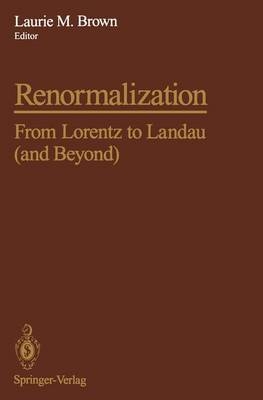
Renormalization
Springer-Verlag New York Inc.
978-0-387-94401-2 (ISBN)
- Titel ist leider vergriffen;
- Artikel merken
The purpose of this section is to give you a sketch of how quantum field theory works, where Feynman graphs come from and why they are so useful, where the infinities come from, and how we have learned to deal with them without compromising the physical principles involved. I am purposely treating the problem at the level of the 1940s and 1950s, so as to keep the basic ideas clear and avoid the more difficult problems and more sophisticated methods of recent years. I shall relate my discussion simply to quantum electrodynamics (QED) since that is the most familiar case and the case that was in the forefront from the beginning (though in fact I shall ignore many of the special complications that have to be dealt with when you quantize a gauge field). The methods I shall be describing are applicable to all sorts of quantized fields: the detailed factors are different but the structure of the logical development isjust the same. Not surprisingly, though, the renormalization procedure breaks down if the theory in question is nonrenormalizable.
Whether nonrenormalizable theories are theories at all is a matter for debate; in any case, they hold no practical interest for physicists since they are essentially unusable. Quantum electrodynamics was devised in 1927 by Dirac, less than a year after the Schrodinger equation appeared and before the Dirac equa- tion for the relativistic electron had been invented.
1 Introduction: Renormalization. 1930-1950.- 1.1. Apologia.- 1.2. Quantum Electrodynamics: 1926-1930.- 1.3. The Decade of Struggle: 1930-1940.- 1.4. The Triumph of Renormalization: The 1940s.- 2 Renormalization in Historical Perspective-The First Stage.- 2.1. Renormalization: The Disappearance and Reappearance of an Idea.- 2.2. J. J. Thompson: The Aether as Fluid and the Electromagnetic Mass.- 2.3. Lorentz: His Aether, Electron, and Program.- 2.4. Kramers: The Unexpected End of the First Phase.- 2.5. Comments and Conclusions.- 3 Tutorial on Infinities in QED.- 3.1. Introduction.- 3.2. Subtracting Infinity.- 3.3. The Perturbation Expansion.- 3.4. Feynman Graphs.- 3.5. Self-Energy Graphs and Vertex Graphs.- 3.6. Primitive Renormalization.- 3.7. The Renormalization Program.- 3.8. Discussion.- 4 New Philosophy of Renormalization: From the Renormalization Group Equations to Effective Field Theories.- 4.1. Conceptual Background.- 4.1.1. The Locality Assumption.- 4.1.2. The Operator Field Assumption.- 4.1.3. The Plenum Assumption of the Vacuum.- 4.1.4. Renormalization and the Consistency of QFT.- 4.2. Foundational Transformations.- 4.2.1. Cutoff.- 4.2.2. Symmetry and Symmetry Breaking.- 4.2.3. Scale Invariance and Renormalization Group Approach.- 4.2.4. Decoupling Theorem and Effective Field Theories.- 4.3. New Philosophy.- 5 Changing Conceptualization of Renormalization Theory.- 5.1. Introduction.- 5.2. The History of Quantum Mechanics and QFT.- 5.3. The Post-World War II Developments.- 5.4. The Changing Conceptualization of Renormalization. Effective Field Theories.- 5.5. The Ebb and Flow of Reductionism.- Appendix Historical Remarks on the Renormalization Group.- A.1. History of RG in Quantum Field Theory.- A.1.1. Renormalization and Renormalization Invariance.- A.1.2. The Birth of the Renormalization Group.- A.1.3. Creation of the RG Method in the Mid-1950s.- A.1.4. Other Early Applications of RG.- A.1.5. Further Development of RG in QFT.- A.2. RG in Critical Phenomena and Other Fields.- A.2.1. Spin Lattices.- A.2.2. Turbulence.- A.2.3. Paths of RG Expansion.- A.2.4. Two Faces of RG in QFT.- A.2.5. Functional Self-Similarity or Synthesis.- A.3. Summary.- Name Index.
| Zusatzinfo | biography |
|---|---|
| Verlagsort | New York, NY |
| Sprache | englisch |
| Maße | 156 x 234 mm |
| Gewicht | 294 g |
| Einbandart | Paperback |
| Themenwelt | Naturwissenschaften ► Physik / Astronomie ► Allgemeines / Lexika |
| Naturwissenschaften ► Physik / Astronomie ► Quantenphysik | |
| ISBN-10 | 0-387-94401-X / 038794401X |
| ISBN-13 | 978-0-387-94401-2 / 9780387944012 |
| Zustand | Neuware |
| Informationen gemäß Produktsicherheitsverordnung (GPSR) | |
| Haben Sie eine Frage zum Produkt? |
aus dem Bereich


